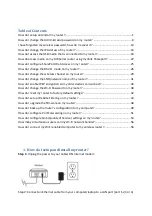
182
www.gateway.com
EAP
The
Extensible Authentication Protocol
(EAP) is an authentication protocol that supports
multiple methods, such as token cards, Kerberos, one-time passwords, certificates, public
key authentication, and smart cards.
Variations on EAP include EAP Cisco Wireless (LEAP), Protected EAP (PEAP), EAP-TLS, and
EAP Tunnelled TLS (EAP-TTLS).
ESS
An
extended service set
(ESS) is an
Infrastructure Mode Wireless Networking Framework
with
multiple access points, forming a single subnetwork that can support more clients than a
basic service set (
BSS
).
Each access point supports a number of wireless stations, providing broader wireless
coverage for a large space, for example, an office.
Ethernet
Ethernet
is a local-area network (
LAN
) architecture supporting data transfer rates of 10 Mbps
to 1 Gbps.
The Ethernet specification is the basis for the IEEE 802.3 standard, which specifies the
physical and lower software layers. It uses the CSMA/CA access method to handle
simultaneous demands.
Ethernet supports data rates of 10 Mbps,
Fast Ethernet
supports 100 Mbps, and
Gigabit
Ethernet
supports 1 Gbps. Its cables are classified as “
X
base
Y
”, where
X
is the data rate in
Mbps and
Y
is the category of cabling. The original cable was
10base5
(Thicknet or “Yellow
Cable”). Some others are
10base2
(Cheapernet),
10baseT
(Twisted Pair), and
100baseT
(Fast
Ethernet). The latter two are commonly supplied using
CAT5
cabling with
RJ-45
connectors. There is also
1000baseT
(Gigabit Ethernet).
Frame
A Frame consists of a discrete portion of data along with some descriptive meta-information
packaged for transmission on a wireless network. Each frame includes a source and
destination
MAC
address, a control field with protocol version, frame type, frame sequence
number, frame body (with the actual information to be transmitted) and frame check
sequence for error detection. A Frame is similar in concept to a
Packet
, the difference being
that a packet operates on the Network layer (layer 3 in the OSI model) whereas a frame
operates on the Data-Link layer (layer 2 in the OSI model).
Gateway
A
gateway
is a network node that serves as an entrance to another network. A gateway
also often provides a proxy server and a firewall. It is associated with both a router, which
use headers and forwarding tables to determine where packets are sent, and a switch or
bridge, which provides the actual path for the packet in and out of the gateway.
Содержание 7001 Series
Страница 1: ...User Guide Gateway 7001 Series Access Point ...
Страница 19: ...14 www gateway com ...
Страница 30: ...25 www gateway com Type the user name and password and click OK ...
Страница 39: ...34 www gateway com Setting configuration policy for new access points ...
Страница 59: ...54 www gateway com ...
Страница 71: ...66 www gateway com ...
Страница 155: ...150 www gateway com 6 Click Finish The access point is now displayed as a client of the Authentication Server ...
Страница 175: ...170 www gateway com ...
Страница 176: ...Chapter 9 171 Troubleshooting and Getting Help Known problems Technical support ...
Страница 179: ...174 www gateway com ...
Страница 180: ...Appendix A 175 Glossary ...
Страница 201: ...196 www gateway com ...
Страница 202: ...Appendix B 197 Specifications ...
Страница 206: ...Appendix C 201 Safety Regulatory and Legal Information ...
Страница 213: ...208 www gateway com ...
Страница 218: ...A MAN 7001 SRS ACC PTS GDE R1 05 04 ...
















































